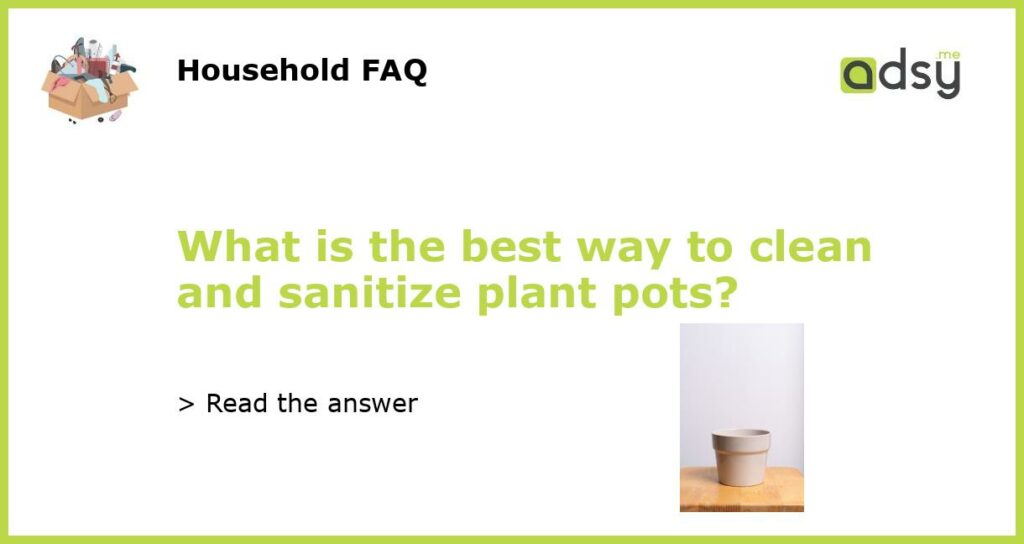Why Is Cleaning and Sanitizing Plant Pots Important?
Cleaning and sanitizing plant pots is an essential task for any gardener or plant enthusiast. There are several reasons why it is important to maintain clean and sanitized pots:
- Prevents the spread of plant diseases: Dirty and contaminated pots can harbor pathogens, fungi, and bacteria that can infect your plants. By cleaning and sanitizing the pots, you can remove any potential sources of infection and protect the health of your plants.
- Improves plant growth and health: Clean pots provide a healthier environment for your plants to thrive. They allow for better air circulation, water drainage, and nutrient uptake, which can ultimately result in improved plant growth and overall health.
- Prevents pest infestations: Plant pots that are not cleaned and sanitized regularly can become a breeding ground for pests such as gnats and fungi. By keeping your pots clean, you can prevent these unwanted invaders from taking over your plants.
- Allows for efficient watering: Over time, mineral deposits and salts can build up on the inside of plant pots, hindering proper water drainage. Regular cleaning can prevent this buildup and ensure that water flows freely through the soil and out of the drainage holes.
How to Clean Plant Pots
Now that you understand the importance of cleaning and sanitizing your plant pots, let’s explore the best way to do it:
- Empty the pots: Start by emptying the pots of any remaining soil or plant debris. Carefully remove the plants and gently shake off excess dirt.
- Scrub with a brush: Use a stiff brush or sponge to scrub the pots with warm, soapy water. This will help remove any stubborn dirt or residue. Pay extra attention to the insides and bottoms of the pots, as these are the areas most likely to accumulate debris.
- Rinse thoroughly: After scrubbing, rinse the pots thoroughly with clean water to remove any remaining soap or dirt. If necessary, repeat the scrubbing and rinsing process until the pots are clean.
- Disinfect the pots: Once the pots are clean, it is essential to disinfect them to eliminate any potential pathogens or bacteria. You can use a diluted bleach solution (1 part bleach to 9 parts water) or a household disinfectant. Apply the solution to the pots, making sure to coat all surfaces. Let it sit for a few minutes and then rinse thoroughly.
- Dry the pots: After disinfecting, allow the pots to air dry completely before using them again. This will prevent any moisture from being trapped, which could potentially lead to mold or fungal growth.
Tips for Sanitizing Plant Pots
In addition to cleaning, sanitizing your plant pots is crucial to ensure optimal plant health and prevent the spread of disease. Here are a few tips to help you sanitize your pots effectively:
- Use natural alternatives to chemicals: If you prefer to avoid chemical disinfectants, you can use natural alternatives such as vinegar, hydrogen peroxide, or a mixture of water and neem oil. These natural solutions can effectively kill bacteria and fungus.
- Remove mineral deposits: To remove mineral deposits or salt buildup on clay pots, soak them in a vinegar and water solution overnight. Scrub off the residue the next day and rinse thoroughly.
- Consider using new pots: If you have had an ongoing issue with plant diseases or pests, it might be best to start fresh with new pots. This will eliminate any potential lingering pathogens or pests that may be present in the old pots.
- Use different pots for different plant types: To prevent the spread of diseases, use separate pots for different plant types. This will prevent cross-contamination and minimize the risk of disease spread.
Frequency of Cleaning and Sanitizing
Regular cleaning and sanitizing of plant pots is essential for maintaining plant health. The frequency at which you should clean and sanitize your pots depends on several factors:
- Plant type: Some plants are more prone to diseases or pests than others. If you have plants that are particularly susceptible, it is advisable to clean and sanitize their pots more frequently.
- Previous disease or pest issues: If you have had previous issues with plant diseases or pests, it is recommended to clean and sanitize your pots after each use to prevent any lingering pathogens from infecting new plants.
- Seasonal changes: It is a good practice to clean and sanitize pots before planting new plants each season. This helps ensure a clean start and minimizes the chances of disease or pest infestations.
- Visible signs of dirt or contamination: If you notice any visible signs of dirt, mold, or pests in your pots, it is a clear indication that they need to be cleaned and sanitized.
Best Practices for Plant Pot Maintenance
Cleaning and sanitizing your plant pots is just one aspect of maintaining their longevity and optimal performance. Here are a few best practices to keep in mind:
- Proper drainage: Ensure that your pots have sufficient drainage holes to allow excess water to escape. This prevents waterlogging, which can lead to root rot and other plant health issues.
- Regular repotting: Over time, plants outgrow their pots, and the soil loses its fertility. Regularly repotting your plants in fresh soil and larger pots will help them thrive.
- Regularly inspect your plants: Keep an eye out for any signs of disease, pests, or nutrient deficiencies in your plants. Early detection and treatment can save your plants from extensive damage.
- Practice crop rotation: If you have a vegetable or herb garden, practice crop rotation to prevent the buildup of soil-borne diseases. Avoid planting the same crop in the same pot year after year.






